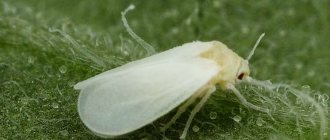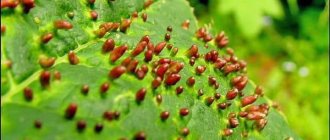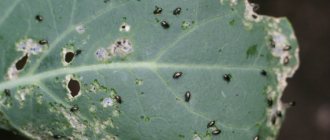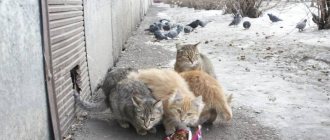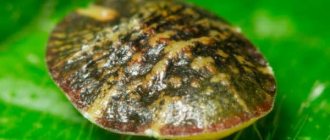The cruciferous flea beetle (Phyllotreta crusiferae), or cabbage flea beetle, is an insect that belongs to the species of flea beetles of the subfamily of the Beetles of the Leaf Beetle family. In nature, you can meet such an insect in the Caucasus, Turkey, Europe, Central Asia, and also in the Mediterranean region. Both adults and larvae eat the foliage of representatives of the Cruciferous (Cabbage) family, namely: radish, horseradish, turnips, all types of cabbage, rapeseed, radish, daikon and rutabaga.
Features of the cruciferous flea beetle
The cruciferous flea beetle is a harmful insect and is a flying beetle that can reach 0.15–0.3 cm in length. The body shape is oval-oblong. There are also antennae that reach no more than 1/3 of the body length. The bug's hind legs are hopping.
Types of cabbage flea beetles differ in the color of their wing covers, which can be striped, black or with a metallic tint. The larvae of such insects eat thin roots of plants. The greatest damage to garden crops is caused by such types of cruciferous flea beetles as: blue, notched, wavy, light-legged and black flea beetles.
How to deal with flea beetles in the garden
Flea beetles on cabbage
The cruciferous flea beetle can settle on cabbage after the air outside warms up to 15 degrees. To avoid freezing in winter, the pest hides under plant debris or in the top layer of soil. The insect damages all cabbage plants in the same way; it can look like skeletonization, ulcerative gnawing, or interveinal gnawing. Those leaf plates that are very damaged begin to dry out and then die; over time, the plant itself begins to die.
Can cruciferous flea beetle cause damage to cabbage at an early stage of development? Insects injure the surface of foliage and shoots, causing sores to appear, which then become holes. Because of this, yellowing of the foliage begins. Injured seedlings may die within just a few days, especially if the weather is very warm. As soon as the bugs are discovered, you need to immediately begin an active fight against them.
How to save cabbage? It is recommended to treat cabbage that belongs to early ripening varieties exclusively with folk remedies, since they do not contain substances hazardous to humans. So, once a week the bushes should be sprayed with an infusion of tobacco or wood ash, a solution of vinegar or a decoction of tomato tops. And you can spray late and mid-season cabbage varieties with special chemicals, for example: Actellik, Karate, Aktara, Decis or Bankol.
Bugs that have settled on radishes, on radishes, or on other representatives of the Cruciferous family can also greatly harm them. The fact is that if the foliage is injured, the root crop will lose nutrition. The fight should begin as soon as the first pests are detected. In order to get rid of them completely, you will need to carry out several sprayings.
Cruciferous flea beetle: 3 effective ways to protect and control
Flea beetles on other crops
The cabbage flea beetle can harm both cruciferous and other crops. It can also injure gillyflowers, roses and chrysanthemums. How to save flowers from cruciferous flea beetle? To control pests, you can use the same drugs as when treating cruciferous crops. However, in this case, insecticidal preparations can be used without fear.
Treat any crops against flea beetles in the evening, when the sun sets, at which time the pests are on the surface of the foliage.
Nuances of struggle depending on culture
The cruciferous flea beetle most often affects cabbage, radishes and radishes. However, eggplant plantings can also suffer from the pest.
Cruciferous flea beetle on cabbage
The pest can be detected on cabbage leaves by characteristic damage - ulcers, skeletonization or interveinal gnawing. The cruciferous flea beetle is especially dangerous for young cabbage: under favorable conditions, seedlings can die in a few days.
There are several ways to destroy the insect population on cabbage:
- Spraying with ash-soap solution . It consists of 10 liters of water, 3 kg of ash and 40 g of laundry soap. The composition must be left for 2 days, then strained. after that you can use it.
- Pepper processing . The procedure must be carried out early in the morning, after the dew has fallen. Black pepper should be sprinkled evenly on each bush.
- Treatment with naphthalene . It is necessary to spray 40 g of naphthalene on an area of 10 m2.
- Pouring the heads of cabbage with cold water . The procedure must be carried out early in the morning, before the first rays of the sun.
Chemical insecticides cannot be used to treat early varieties of cabbage, since their hatching period exceeds the ripening period of the vegetable.
When using dry products or solutions, you must ensure that they cover the cabbage leaf not only from the outside, but also from the inside.
How to deal with cruciferous flea beetle on radishes
The period of activation of the cruciferous flea beetle coincides with the appearance of the first radish sprouts. In a short time, a pest colony can completely destroy young plants. The first sign of impending danger is holes in the leaves.
The following means are used to combat midges:
- Vinegar solution . For 10 liters of water you will need 1 tbsp. 9% vinegar. It is necessary to spray the plantings twice, with an interval of 7-10 days.
- Dandelion infusion . For 10 liters of water - 500 g of plant. Leave for 2 days and add 2 tbsp. l. liquid soap.
- Ash solution and tobacco infusion . The cooking technology is the same as for processing cabbage.
It is not recommended to use insecticides to kill insects on radishes - they do not have time to be removed from the plant before maturity.
How to get rid of flea beetles on eggplants
If there are beds on the site that are infested with cruciferous flea beetle, then insect colonies can reach the eggplants. The following methods are used to control pests:
- Regular watering and preventing the soil from drying out.
- Using glue traps.
- Spraying with garlic infusion. The heads (200 g) must be crushed and poured with 10 liters of water, left for 2-3 days, strained and diluted with water (1:1). Spray eggplants twice at intervals of 3-4 days.
- Treatment with wormwood infusion. Pour 10 liters of boiling water over the herb (1 kg), leave for several hours and dilute in half with cold water. Add 2 tbsp. l. soap Spray affected plants twice.
- Use of chemical insecticides. Aktellik, Aktara, Decis and Arrivo have proven themselves. Processing must be done no later than 1 month before harvest.
To protect eggplant seedlings from cabbage flea beetles, sprinkle the rows with wood ash, ground black pepper or slaked lime.
Effective chemicals
In the fight against cabbage flea beetle, the following insecticidal preparations are most popular among summer residents:
- Aktara . This is a systemic insecticidal preparation of contact-intestinal action that can cope with a large number of different harmful insects, including secretive and sucking insects.
- Aktellik . Organophosphorus non-systemic insectoacaricidal preparation of contact-intestinal action, which is used in the fight against leaf-eating and sucking harmful insects.
- Karate . A contact-system combined insecticidal agent used to control sucking and gnawing pests.
- Bankol . This is an insecticidal preparation of contact-intestinal action that destroys sucking and gnawing harmful insects.
- Decis . A broad-spectrum contact-intestinal insecticide from the pyrethroid group. It effectively fights lepidopteran, coleopteran and homoptera harmful insects.
In addition to these drugs, you can use Inta-Vir, Mospilan, Fitoverm and others with similar effects.
SUPER REMEDIES FOR CRUCIFLOWER FLEAS!!!
Folk remedies
It is recommended to spray vegetable crops affected by the cruciferous flea beetle with chemicals only as a last resort, because they contain poisons that are dangerous to both humans and beneficial insects. Instead of chemicals, experienced gardeners advise using folk remedies, which are not only safe, but also quite effective.
Most often, gardeners use the following effective folk remedies to combat the pest:
- Immediately after transplanting into open ground, seedlings must be dusted with wood ash; you can also use tobacco dust combined with ash (1:1). Pollination is carried out on a fine, windless day, and there should be no rain in the near future after treatment. This procedure is carried out three times with a break of 4 or 5 days. After pollination of all leaves, both surfaces should be covered with the composition.
- Vegetable crops should be sprayed with a decoction made from tomato tops: combine 2 kg of dry or 4 kg of fresh tops with a bucket of cold water, wait four hours and boil the mixture over low heat for 30 minutes. The cooled and strained broth is combined with water in a 1:1 ratio and with grated or liquid soap, taken in an amount of 40 grams. The bushes are treated with the composition three times with a break of three or four days.
- Pass 1 tbsp through a meat grinder. garlic and the same amount of tomato tops. The resulting mass is poured with a bucket of lukewarm water. Mix everything well and strain. One large spoon of liquid soap is poured into the resulting product, after which the bushes are sprayed with the resulting product.
- 500 g of dandelion roots and leaves are combined with a bucket of water, do not forget to chop them first. Mix the product well and strain it. Before processing, pour a little liquid soap into it.
- A bucket of water is combined with a couple of glasses of wood ash. The mixture should steep for two days, after which it is carefully drained and ¼ of a bar of tar soap, which is first ground on a grater, is dissolved in the resulting product.
- 10 liters of hot water are combined with 0.2 kg of tobacco dust. The cooled and strained infusion is combined with one large spoon of dishwashing detergent or liquid soap.
- 10 liters of water are combined with 2 large spoons of vinegar essence or 1 tbsp. vinegar (9%). Spray the foliage with a well-mixed solution.
- A couple of liters of water are combined with 1 kg of finely chopped wormwood. The mixture is boiled over low heat for 10–15 minutes. The cooled broth is mixed with 100 grams of chopped garlic and filtered. The volume of the resulting product is brought to 10 liters with clean water.
- 5 liters of water are combined with 2 kilograms of potato tops and boiled over low heat for half an hour. The cooled broth is filtered and diluted twice with water. The treatment is carried out in the evening.
- Prepare an infusion of chicken manure in a ratio of 1:20. It is kept in the open air for seven days, after which it is filtered and you can begin processing. This infusion will not only repel fleas, but will also become a source of nitrogen for plants.
- Half a bucket of water is combined with one tablespoon of flea remedy (sold at a pet store). The resulting solution is sprayed onto the bushes.
- A flag is made from cardboard or thin plywood, both surfaces of which are coated with grease or resin. Walk several times along the rows of plants where flea beetles have settled, do not forget to wave the flag and touch the foliage with it. Frightened pests will start jumping and most of them will stick to the flag.
- Take several pieces of cloth and soak them in used car or diesel oil. Distribute them on sheets of cardboard between the rows in the beds, and the distance between them should be about four meters. After two or three days, you need to turn the fabric over to the other side, which will allow you to collect many more pests.
How easy it is to get rid of cruciferous flea beetle forever!
How to get rid of cruciferous flea beetle on cabbage and radishes
There are other folk ways to combat fleas. After all, chemicals cannot always be used. For example, radish is an early ripening crop; the use of chemicals is not advisable for it. Therefore, take into account the products that are used to spray the plants.
- Birch tar . For 1 liter of water add 1 tsp. tar, shake well in water. Since birch tar does not dissolve well and settles on the walls of the watering can, experienced gardeners advise first stirring the tar with liquid soap, and then slowly adding water and only then spraying the plants.
- Ash infusion . Pour boiling water over the wood ash in a ratio of 1:3, leave to steep for two days, then strain and add liquid or soaked laundry soap, then spray the plantings.
- Garlic solution . Pass 1 cup of garlic and the same number of tomatoes through a meat grinder. Dilute the mixture with 10 liters of water, strain, add 1 tbsp. l. liquid soap and start spraying.
- Solution with dandelions . Grind 500 g of dandelion leaves and roots in a meat grinder, dilute the mixture in 10 liters of water, strain. Add 1 tbsp. l. soap The solution is ready for use.
How to fight cruciferous flea beetle with vinegar
Pests do not like strong odors; the use of table vinegar is based on this property; it has a detrimental effect on bugs. If you take vinegar essence, then dilute it at the rate of 1 tbsp. l. essences per 10 liters of water. When using 9% table vinegar, it is enough to dilute 1 tsp. for 1 liter of water. Remember that you need to spray on dry foliage.
Ammonia to combat cruciferous flea beetle
To prepare the working solution, 1 tsp. ammonia is diluted in 1 liter of water, stirred and sprayed on the plants. The treatment is carried out on dry leaves. When treating with ammonia, in addition to repelling pests, you also fertilize. Ammonia is like a nitrogen plant.
A similar action - processing and fertilizing at the same time - is used when using a weak solution of chicken manure. The leaves, absorbing nitrogen fertilizing, will develop faster, gain strength, and become stronger. The coarsened leaves will no longer be suitable for the bugs and they will not eat them willingly.
How to carry out preventive treatments
Experts advise that it is better to prevent cabbage flea fleas from appearing on the site than to try to get rid of it. Preventive measures:
- After the seedlings are transplanted into open ground, they are covered with non-woven material. After the seedlings get stronger, their foliage will become coarser and will no longer attract fleas. At this time it will be possible to remove the shelter.
- The smell of coriander, dill and garlic repels this pest, so it is recommended to grow cabbage next to them. When growing late varieties of cruciferous crops, you can protect them from such a harmful insect by using mixed plantings with nasturtium, marigolds or calendula.
- Every day, freshly picked wormwood should be placed between the rows in the beds.
- In the water intended for irrigation, you need to pour 10-15 drops per bucket of aromatic agents such as valerian tincture, Corvalol, pine or fir oil.
Some agrotechnical rules will also help prevent cruciferous flea beetles from appearing on your site:
- Systematically pull out weeds, as the cruciferous flea beetle likes to settle on it.
- In the autumn, when the harvest is harvested, the soil in the garden is dug up.
- Water and fertilize the plants on time, thanks to this they will quickly get stronger, grow and become less attractive to the pest.
- It is recommended to plant crops as early as possible, before this harmful insect has yet awakened. Also, seedlings can be planted in the last days of June, when the flea will no longer be too scary for it.
Cruciferous flea flea / I fight with folk remedies / Night “hummingbird”
How to prevent the appearance of cruciferous flea beetle on plants
It is best to prevent the appearance of the pest in advance. Preventive measures are based on how the pest lives and reproduces.
- Fleas are most active in dry, hot, sunny weather. In cool, damp weather they are less active. Therefore, water plant seedlings and cabbage seedlings more often; pests do not like damp soil.
- To reduce damage from insects next year, dig up the area before winter as late as possible, literally before the frost itself. This will release overwintering bugs to the soil surface. If you dig up early, the bugs will go underground again and quietly overwinter there.
- In addition, it is necessary to observe crop rotation and plant cruciferous crops in a different place every year. When planning the beds, keep in mind that for cabbage, radishes, radishes, arugula, etc., allocate other places where cruciferous crops have not previously grown.
- In early spring, before planting seedlings and sowing early-ripening cruciferous vegetables, the beds must be kept clean, that is, weed them in advance. This will not create conditions for the bugs flying out of the ground to feed.
- Among cabbage, turnips, radishes, watercress, arugula, plant dill, garlic, coriander, caraway seeds, as well as marigolds and calendula. Their pungent smell will repel pests.
Related article: Cherry tree: planting and care, photo, pruning, grafting, description of varieties, diseases and pests
